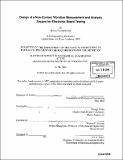| dc.contributor.advisor | George Costa and Warren P. Seering. | en_US |
| dc.contributor.author | Arn, Krissa Elizabeth, 1980- | en_US |
| dc.contributor.other | Massachusetts Institute of Technology. Dept. of Mechanical Engineering. | en_US |
| dc.date.accessioned | 2005-06-02T19:51:27Z | |
| dc.date.available | 2005-06-02T19:51:27Z | |
| dc.date.copyright | 2004 | en_US |
| dc.date.issued | 2004 | en_US |
| dc.identifier.uri | http://hdl.handle.net/1721.1/18070 | |
| dc.description | Thesis (S.M.)--Massachusetts Institute of Technology, Dept. of Mechanical Engineering, 2004. | en_US |
| dc.description | Includes bibliographical references (p. 107). | en_US |
| dc.description.abstract | Traditional vibration measurement methods involve placing accelerometers at discrete locations on a test object. In cases where the test specimen is small in mass, the addition of these measurement transducers can alter its dynamic behavior and lead to erroneous test data. In this thesis a Non-Contact Vibration Measurement and Analysis System has been designed, built, and tested for electronic board testing. Through a product design process, all feasible methods were considered and three optically based concepts were explored: holographic interferometry, area scaling, and displacement sensor grid. Through concept testing and analysis, the displacement sensor grid method was chosen for the design. The final system incorporates four laser displacement sensors with a vertical scrolling mechanism that attaches to the vibration table's side rails. This manual scanning system provides a quick, low cost method for capturing multiple points on the test object during vibration testing. The MATLAB based software package acquires the raw sensor output and processes it with a five step analysis program. With this software, an 8x4 grid of electronic board displacements were easily transformed into a movie showing the board displacing through its first mode. The system requires the sensors be positioned lcm away from the test object with the sensors reading up to [plus-minus]lmm of movement. The sensors have a maximum sample rate of 7.8 kHz and can be used to measure the displacements of any surface type or material. The measurement grid resolution is 0.7 inches horizontally 0.4 inches vertically. Testing showed that the system captured the natural frequency and peak displacement of the board's first mode within 1.5% accuracy and 0.7% accuracy respectively | en_US |
| dc.description.abstract | (cont.) when compared with previous accelerometer grid testing. Exceeding its design goals, this non-contact measurement and analysis device provides a highly versatile, accurate, and low cost optical alternative to accelerometers. Also it shows numerous benefits over more complex and costly optical measurement methods. The use of this system eliminates any question of whether mass loading effects are tainting vibration test data. A hardware and software manual are included for reference at the end of this thesis along with a software CD. | en_US |
| dc.description.statementofresponsibility | by Krissa Elizabeth Arn. | en_US |
| dc.format.extent | 136 p. | en_US |
| dc.format.extent | 6716674 bytes | |
| dc.format.extent | 6734434 bytes | |
| dc.format.mimetype | application/pdf | |
| dc.format.mimetype | application/pdf | |
| dc.language.iso | eng | en_US |
| dc.publisher | Massachusetts Institute of Technology | en_US |
| dc.relation.requires | CDROM contains Non-Contact Laser Vibe System Software. Also contains hardware manual, software manual and a copy of the thesis in .doc format. | en_US |
| dc.rights | M.I.T. theses are protected by copyright. They may be viewed from this source for any purpose, but reproduction or distribution in any format is prohibited without written permission. See provided URL for inquiries about permission. | en_US |
| dc.rights.uri | http://dspace.mit.edu/handle/1721.1/7582 | |
| dc.subject | Mechanical Engineering. | en_US |
| dc.title | Design of a non-contact vibration measurement and analysis system for electronic board testing | en_US |
| dc.type | Thesis | en_US |
| dc.description.degree | S.M. | en_US |
| dc.contributor.department | Massachusetts Institute of Technology. Department of Mechanical Engineering | |
| dc.identifier.oclc | 57562181 | en_US |
